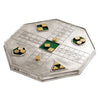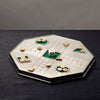Ludo 'Ludo' Game - 24 cm x 24 cm - Handcrafted in Italy - Pewter
Cosi Tabellini's craftsmen have reverently handcrafted, from high quality pewter, an authentic version of the classic game of Ludo; a very pleasurable game that can be enjoyed by young and old alike - it is designed for two, three or four players.
Buying as a gift? Why not make it even more special with our engraving service?
Ludo is a simplification of the 6th Century Indian game "Pachisi", where amongst other variations, the six shells used in the original game were replaced by just one die. The game was introduced in England in 1896, and the name Ludo is derived from the Latin verb 'ludo', which means to 'play, trick or tease'.
The Ludo board is in the shape of a cross, with each four arms of the cross divided into three adjacent columns of six squares. The middle squares form the home column for each player and cannot be landed upon by other players. The middle of the cross forms a large square which is the 'home' area. At each corner of the board are different shapes, where each player's pieces are placed to begin. Tokens start their circuit from the coloured first square, one square in from the end of the arm.
The objective is for each player to move their tokens around the perimeter of the entire board from their respective starting square in a clockwise direction, and when the token returns to their home column, they move it forwards up the column with the intention of landing it in the centre 'home' area, and the process is repeated for each token to beat their opponents. although tokens can be staggered, so that more than one token can be 'in play' at the same time.
RULES:
1. The die shall be cast to decide the order of game; the higher score determines the player who is to play first; the game proceeds clockwise.
2. At the beginning of the game, the pawns are in the "bases" corresponding to their geometric figure. To start the route it is necessary to roll a 6. In some variations of the game, and to get the game moving faster, some house rules allow a player to bring their first piece into play on any roll, or on a 1 or a 6, or if the '6' is maintained, then allowing the player multiple rolls to increase the likelihood of landing on it. This is a suggested variation for when playing with young children.
3. The 6 points rolled are used to put a pawn into the starting square, and the player can start their journey across the board in a clockwise direction. by advancing the token six squares.
4. Once play has moved round, and the player has a subsequent roll, if the player scores another 6 then it is the player's choice whether to advance a token already in play, or alternatively, to enter another token into active play. The player moves the token forward along the track the number of squares indicated by the number on die rolled.
5. The roll of 6 gives the right to another 'bonus' cast; if the player rolls a 6 again, then a second bonus cast is granted. If the same player lands a further 6, then the player forfeits a go and can't move a token.
6. The score of the die cannot be divided to move more pawns.
7. If a pawn ends up in a square already occupied by an adversary, the pawn that was already there is sent back to the "base" and must start again from the beginning . To start again it must roll a 6.
8. If a player has 2 or more pawns placed in the same square nobody (not even the same player) shall overtake them or send him back to the "base". The adversary loses the cast, unless he can use the score in favour of another pawn. The pawns in the same square cannot be moved simultaneosly.
9. It is impossible to abstain from using one's score even if it turns out to be harmful.
10. To be allowed to enter into the central "house" at the end of the route, it is necessary to get the exact score. If this is not possible and the player has no other pawn to play, the pawn shall be let into the "house" and than sent back for as many squares as the points in excess are.
11. The player who makes their four pawns run the whole route and makes them get to the house first, wins the game.
Cosi Tabellini's pewter die shaker, or die shaker and board, would complement the Ludo game very well.
For older children and adults seeking further variations to the game of Ludo, try incorporating the rules of Pachisi, Chaupur or Uckers into the game.
Size: 24 cm x 24 cm
Weight: 780 g
Materials Used: Pewter
Ref: CT0100901
Designer: Alberto Tabellini
100% Lead Free
All Cosi Tabellini Pewter is 100% lead-free, so it is totally food & drink safe, and is both EU and US FDA approved.
Packaging
Cosi Tabellini pieces come gift-boxed with a guarantee card and instructions on how to care for pewter.





